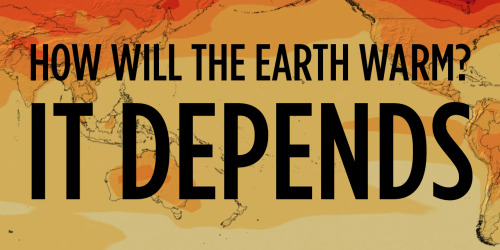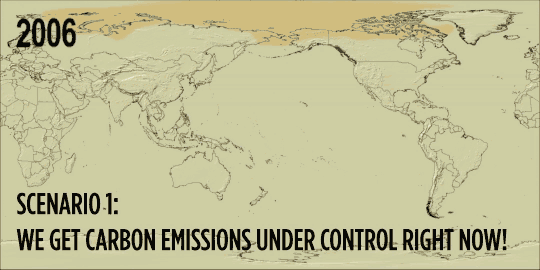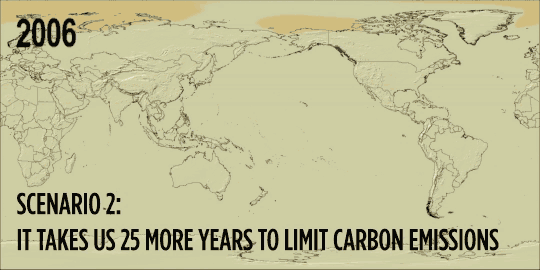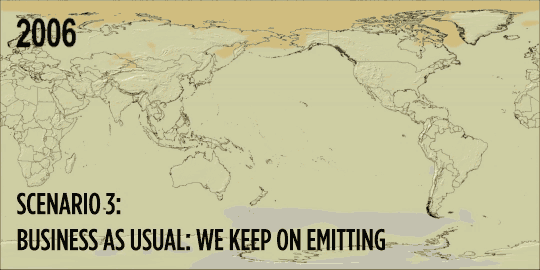As Governments Discuss Climate Change In Paris, They’ll Be Referring To The Dire Predictions Of Climate





As governments discuss climate change in Paris, they’ll be referring to the dire predictions of climate scientists. Here are three visualizations of possible futures based on detailed climate models and summed up by the United Nations’ Intergovernmental Panel on Climate Change (IPCC) in their 2013 report. The deeper the red - the hotter things are getting.
The message is clear: we better act fast.
How did they come up with these models? Read or listen to Nell Greenfieldboyce’s story.
Image Credit: NASA’s Scientific Visualization Studio and NASA Center for Climate Simulation
More Posts from Envirographs and Others


Preparedness for climate change (top) and coastal flooding (bottom), from States at Risk

Everglades (and south Florida, including Miami) with 4ft of sea level rise

Change in mean sea level over the past two decades. The lull in 2011 was the result of La Nina, not a pause in climate change.


“Employment in the U.S. solar business grew 12 times faster than overall job creation... Fed by state initiatives to spur clean energy and innovative financing measures offered by companies such as SolarCity Corp., developers are adding workers at record rates to install rooftop panels. Oil and gas producers by contrast have slashed 351,410 jobs worldwide since prices began to slide in the middle of 2014, according to Houston-based Graves & Co.... This increase is being driven by declining renewable energy technology costs and enabling policy frameworks. We expect this to continue as the case for renewables strengthens and countries move to achieve climate targets... The group projects the workforce in clean energy will grow to 24 million by 2030 if United Nations targets are met on climate change and development.” - Bloomberg

Geographical distributions of penguin species



From The Guardian:
In the past two decades, 10% of the earth’s wilderness has been lost due to human pressure, a mapping study by the University of Queensland has found... These pristine wild places exist in inhospitable locations: the deserts of Central Australia; the Amazon rainforest in South America; Africa; the Tibetan plateau in central Asia; and the boreal forests of Canada and Russia. They are being encroached on by logging, oil and gas exploration, mining, roads and agriculture.

The conservation status of turtles and tortoises, nearly 60% of which are threatened. Many critically endangered turtles are in Asia, such as the Yunnan Box Turtle, Yangtze Giant Softshell Turtle and Philippine Pond Turtle. The leatherback and hawksbill sea turtles are also critically endangered.

“Over the past year, seven of the estimated 80 remaining Texas ocelots were killed by vehicles. Six of these mortalities were adult males. Among ocelots, it is not easy to be a maturing male. In order to prevent competition for access to breeding females, older males often force the younger males to leave the area where they grew up, sending them out to find females and territory of their own. Once out of protected, dense brush habitat areas, these younger males encounter the human-developed world and all of its dangers, in particular roads and vehicles. In reaction to the large proportion of road mortalities being males, Dr. Hilary Swarts, a wildlife biologist who monitors ocelots in south Texas with the U.S. Fish and Wildlife Service (USFWS) said, ‘I can’t say it’s surprising that six of the seven deaths were males, since they have such a rough time of it once the older males start to see the younger males as competition for mates and territory.’” - See more at: http://blog.cincinnatizoo.org/#sthash.YjGoogOC.dpuf

Biodiversity hotspots around the world
-
 plastic-pitbull liked this · 11 months ago
plastic-pitbull liked this · 11 months ago -
 bakuswift liked this · 11 months ago
bakuswift liked this · 11 months ago -
 brimotrimorphos liked this · 11 months ago
brimotrimorphos liked this · 11 months ago -
 unadulteratedmagazinecat liked this · 11 months ago
unadulteratedmagazinecat liked this · 11 months ago -
 femily-thiccinson reblogged this · 11 months ago
femily-thiccinson reblogged this · 11 months ago -
 ilyena-rose liked this · 11 months ago
ilyena-rose liked this · 11 months ago -
 torposopla reblogged this · 11 months ago
torposopla reblogged this · 11 months ago -
 hadesoftheladies reblogged this · 11 months ago
hadesoftheladies reblogged this · 11 months ago -
 ratatattouille liked this · 11 months ago
ratatattouille liked this · 11 months ago -
 wjscosplayphotography liked this · 2 years ago
wjscosplayphotography liked this · 2 years ago -
 notmrkillwolf666 reblogged this · 3 years ago
notmrkillwolf666 reblogged this · 3 years ago -
 notmrkillwolf666 liked this · 3 years ago
notmrkillwolf666 liked this · 3 years ago -
 shhvictoria liked this · 4 years ago
shhvictoria liked this · 4 years ago -
 silvercrane14 liked this · 5 years ago
silvercrane14 liked this · 5 years ago -
 put-the-needle-through liked this · 5 years ago
put-the-needle-through liked this · 5 years ago -
 velvetcatnip liked this · 5 years ago
velvetcatnip liked this · 5 years ago -
 master7mindd reblogged this · 5 years ago
master7mindd reblogged this · 5 years ago -
 happybean17 liked this · 5 years ago
happybean17 liked this · 5 years ago -
 oneoctobernight liked this · 5 years ago
oneoctobernight liked this · 5 years ago -
 uglynine liked this · 5 years ago
uglynine liked this · 5 years ago -
 wittymoonboy liked this · 5 years ago
wittymoonboy liked this · 5 years ago -
 famouspalacecashspy-blog liked this · 5 years ago
famouspalacecashspy-blog liked this · 5 years ago -
 goldlipstick liked this · 5 years ago
goldlipstick liked this · 5 years ago -
 antrey-o reblogged this · 5 years ago
antrey-o reblogged this · 5 years ago -
 pali6273 liked this · 5 years ago
pali6273 liked this · 5 years ago -
 go-wind-stuff reblogged this · 5 years ago
go-wind-stuff reblogged this · 5 years ago -
 faggotjoke reblogged this · 6 years ago
faggotjoke reblogged this · 6 years ago -
 faggotjoke liked this · 6 years ago
faggotjoke liked this · 6 years ago -
 goldenfield liked this · 6 years ago
goldenfield liked this · 6 years ago -
 blogquantumreality liked this · 6 years ago
blogquantumreality liked this · 6 years ago -
 amazonprimebox liked this · 6 years ago
amazonprimebox liked this · 6 years ago -
 happycomputerlover liked this · 6 years ago
happycomputerlover liked this · 6 years ago -
 sloptown liked this · 6 years ago
sloptown liked this · 6 years ago -
 awfullynice-hq liked this · 6 years ago
awfullynice-hq liked this · 6 years ago -
 carerra73 liked this · 6 years ago
carerra73 liked this · 6 years ago -
 madyoice liked this · 6 years ago
madyoice liked this · 6 years ago -
 principessapenelope reblogged this · 6 years ago
principessapenelope reblogged this · 6 years ago -
 principessapenelope liked this · 6 years ago
principessapenelope liked this · 6 years ago
A visual exploration of environmental problems, movements and solutions.
151 posts


